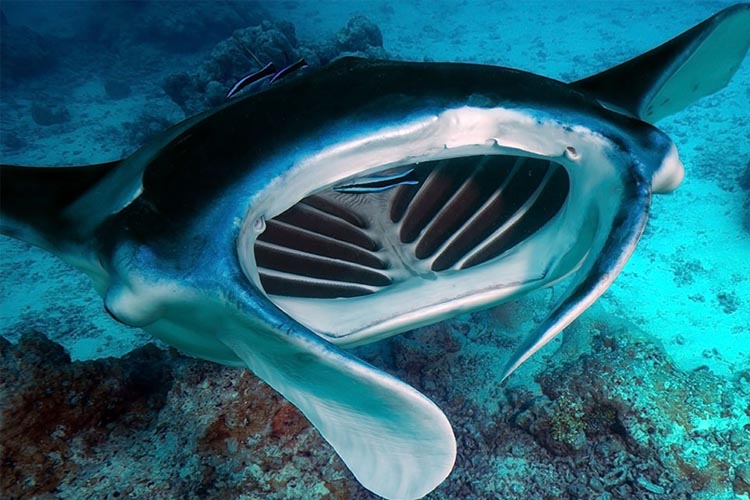
New research published by scientists from the Marine Megafauna Foundation, Macquarie University, the University of Cape Town, and the University of Papua, has observed that manta rays move their cephalic lobes – the modified fins located on either side of a manta ray’s mouth – in ‘specific and interesting ways’ during social interactions. The study, published in Behavioral Ecology and Sociobiology, suggests that cephalic lobes are important as a means of communication, as well as being used for feeding.
Previous research by the team around Raja Ampat, in the Indonesian province of West Papua, has shown that reef manta rays (Mobula alfredi) are social animals, with individuals recognising and remembering their ‘friends’ and forming distinct social groups. The new study looks to determine how individual animals communicate and transfer information between group members, knowledge which will be important in expanding the understanding of manta ray behaviour and extend better protections for the preservation of a species whose populations have been decimated in recent years.
The scientists observed the behaviour of manta rays at cleaning stations, where they are known to congregate in groups to interact socially and engage in reproductive behaviour, as well as being cleaned. The team recorded all the movements made by the paired cephalic lobes on the sides of manta rays’ heads, and the exact timing of the signals in relation to the context in which they occurred.
A variety of specific positions and movements of the cephalic lobes were observed, with some more frequent and sustained during social encounters. Certain movements, such as small flicks of the lobe tips, were performed more frequently when rays were facing another individual, while tight rolling of the lobes was associated with being followed by others.
Related articles

Other lobe movements were made more frequently when the mantas were interacting closely with cleaner fish, perhaps to attract their attention. Streamlined lobe positioning during swimming and the presence of zooplankton was also thought likely to be important.
The researchers observed a wide variety of cephalic lobe movements, suggesting that manta rays’ intelligence is even greater than it is already known to be – and that significantly more research is required to further understand a creature that has already been shown to exhibit complex patterns of behaviour.
‘It’s always been very difficult for us to understand communication in other species, particularly those such as manta rays that are so obviously different to us, but it is likely that these animals can communicate in a fairly sophisticated way,’ said Rob Perryman, lead author of the study and PhD student at Macquarie University. ‘Here, we provide evidence that suggests that a potential way in which communication may occur in manta rays, by using gestures similar to those known to be important in related shark species. Our results add to the growing evidence that manta rays are fundamentally a social species, which is crucial knowledge for conservation.’
‘It is a humbling experience to record hundreds of hours of manta ray behaviour and gain insights into what they might be doing with their cephalic lobes, which seem to have other uses than the traditional view that they are just used in feeding,’ said Michelle Carpenter, the study’s lead observer and PhD student at the University of Cape Town. ‘The one finding that stuck out to me was that they were always moving their cephalic lobes when approaching a stimulus – another manta, a human diver, cleaner fish. This provides an argument that mantas are sensing their local environment with their cephalic lobes. Manta rays are incredibly complex creatures and animal behaviour is a tough subject, which makes these things hard to confirm.’
Manta rays have been protected in Indonesia since 2014, but artisanal fishing remains a problem for the local populations, and there is little global awareness of the threats the species face. The team hopes that by demonstrating complex communication behaviour as part of the social nature of manta rays will help broaden support and public enthusiasm for their protection around the world.
‘Collecting information about manta rays’ social interactions, particularly at sites such as cleaning stations where they regularly come into contact with divers, is important to develop sustainable ecotourism and conservation initiatives that allow mantas to coexist with humans in their natural habitats,’ said Perryman. ‘Furthermore, it adds to their overall perception by humans and demonstrates just how fascinating and complex these animals are.’


